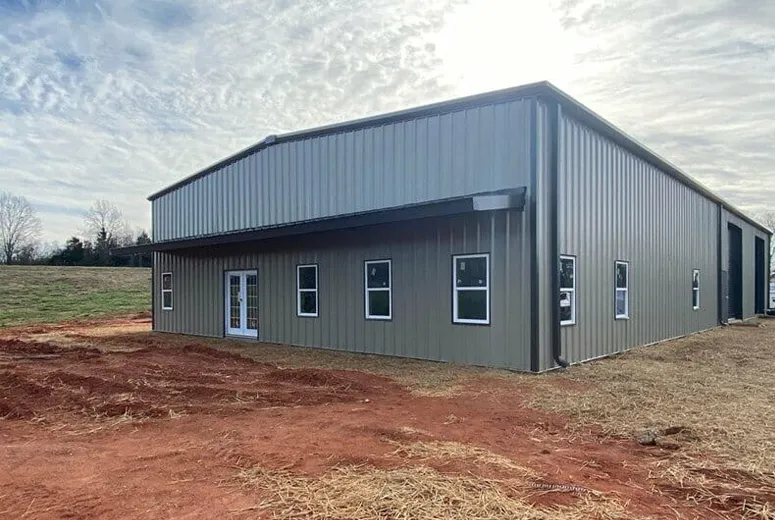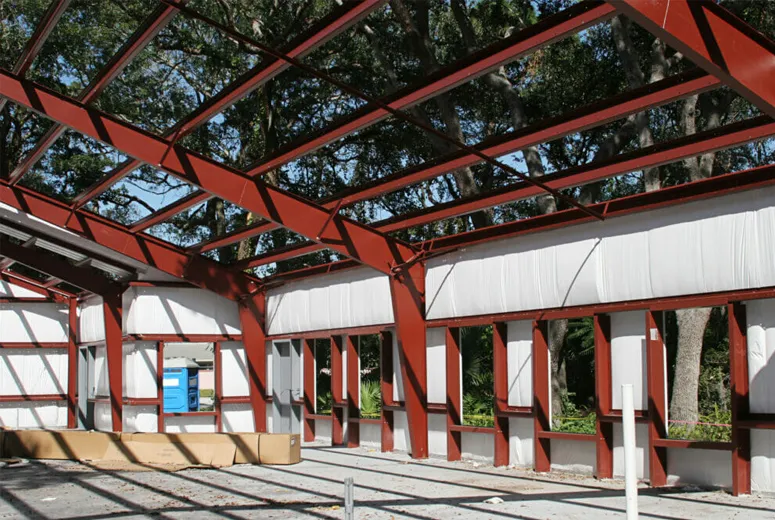Metal steel office buildings have become a preferred choice for modern commercial spaces due to their durability, flexibility, and cost-efficiency. These buildings combine practicality with sleek, contemporary designs, making them suitable for various professional environments.
1. Durability and Strength
Steel is one of the most robust construction materials, offering excellent resistance to environmental challenges such as extreme weather, fire, and pests. Metal steel office buildings are designed to last for decades with minimal maintenance, ensuring a stable and secure workspace.
2. Customizable Design
Steel structures provide unparalleled design flexibility. They allow for open floor plans, high ceilings, and creative layouts that cater to various office needs. This adaptability supports the integration of conference rooms, workstations, and communal spaces without compromising the building’s structural integrity.
3. Quick Construction
Prefabricated steel components streamline the construction process, reducing labor costs and project timelines. This speed makes steel office buildings an efficient solution for businesses looking to establish operations quickly.
4. Energy Efficiency
Modern steel buildings are compatible with advanced insulation, energy-efficient windows, and HVAC systems. These features help maintain comfortable indoor temperatures while reducing energy consumption and utility costs.
5. Eco-Friendly and Sustainable
Steel is a recyclable material, making it an environmentally friendly choice. The construction process also generates less waste, aligning with sustainable building practices.
6. Cost-Effectiveness
Steel office buildings offer long-term savings through lower maintenance, energy efficiency, and reduced insurance costs due to their resilience.
In conclusion, metal steel office buildings provide a durable, versatile, and sustainable solution for businesses, blending functionality with modern design.
What are the disadvantages of building with metal?
While metal buildings offer many advantages, such as durability, strength, and quick construction, there are some potential drawbacks to consider when deciding whether to use metal as a building material.
1. Higher Initial Costs
Although metal buildings can be cost-effective over the long term, the initial cost of materials and labor can be higher than traditional construction methods like wood framing or brick. The price of steel and metal components fluctuates, which can affect project budgets.
2. Insulation Challenges
Metal buildings can be prone to heat transfer, which may lead to temperature imbalances. Without proper insulation, metal structures can become too hot in the summer and too cold in the winter. This issue requires investment in insulation materials and HVAC systems to ensure comfort and energy efficiency.
3. Corrosion and Rust
While metal is highly durable, it can be susceptible to rust and corrosion, especially in areas with high humidity, saltwater exposure, or heavy rainfall. Protective coatings and regular maintenance are essential to prevent corrosion, which can add to the overall upkeep costs.
4. Noise Issues
Metal buildings tend to amplify sound, leading to noise issues, especially in large open spaces or industrial environments. Without proper insulation or soundproofing, metal buildings can become noisy, affecting productivity and comfort.
5. Limited Aesthetic Appeal
While metal buildings can be designed to look modern and sleek, some people may find them less visually appealing compared to traditional brick or wood structures. Achieving the desired aesthetic may require additional customization or cladding, increasing costs.
In conclusion, while metal buildings offer numerous benefits, potential disadvantages such as high upfront costs, insulation needs, and maintenance concerns should be considered when planning a construction project.
What Are Most Office Buildings Made Of?
Most office buildings are constructed using a variety of materials that provide strength, durability, and aesthetic appeal. The materials used depend on the type, location, and purpose of the building, but the most common materials include steel, concrete, glass, and wood.
1. Steel
Steel is a primary material used in the framing of most modern office buildings. Its high strength-to-weight ratio allows for taller buildings with larger open spaces and fewer columns. Steel is ideal for supporting heavy loads and withstanding various environmental challenges, making it an excellent choice for both structural support and overall stability.
2. Concrete
Concrete is another essential building material used in the construction of office buildings, particularly for the foundation, floors, and structural walls. Reinforced concrete, which includes steel bars or mesh for added strength, is commonly used to provide stability and durability. Concrete is also effective for soundproofing and fire resistance, offering safety and comfort within office spaces.
3. Glass
Glass is widely used for exterior facades and windows in modern office buildings. It allows natural light to penetrate the interior, reducing the need for artificial lighting and creating a more pleasant working environment. Glass also enhances the building’s aesthetic, contributing to a contemporary, sleek look. However, glass requires careful energy management to control heat gain or loss.
4. Wood
Though less common for large office buildings, wood is used in certain interior elements, such as paneling, flooring, and cabinetry. It provides a natural and warm appearance, contributing to a welcoming atmosphere within office spaces.
In conclusion, the materials used in most office buildings—steel, concrete, glass, and wood—combine to offer strength, functionality, and aesthetic value, meeting the diverse needs of modern commercial spaces.
Why Choose a Metal Office Building?
Metal office buildings have become an increasingly popular solution for modern businesses looking for a combination of strength, efficiency, and adaptability. Built from high-quality steel, these buildings are known for their exceptional durability, capable of withstanding extreme weather conditions including heavy winds, snow, and even seismic activity. For companies prioritizing safety and structural longevity, a steel office building is a reliable investment.
One of the most attractive features of a metal office building is its design flexibility. Unlike traditional brick or wood structures, steel framing allows for wide, open-span interiors without the need for internal load-bearing walls. This means you can create spacious, column-free layouts—ideal for collaborative office spaces, meeting rooms, or integrating warehouse and storage areas into a single structure. Whether you're building from scratch or expanding an existing facility, the design possibilities are virtually endless.
Speed of construction is another significant advantage. Prefabricated metal components are manufactured off-site and then quickly assembled on location, drastically reducing construction time. Businesses that need to move into a new space quickly or scale operations without delay will appreciate this efficiency. Faster build times also reduce labor costs and minimize disruptions to daily business operations.
Affordability is a key factor for many organizations, and metal office buildings for sale are generally more cost-effective than traditional alternatives. Steel construction not only reduces upfront expenses but also lowers long-term maintenance costs. These buildings are resistant to pests, rot, mold, and fire, reducing the need for frequent repairs and upkeep. Combined with energy-efficient insulation options, businesses can also benefit from reduced heating and cooling bills over time.
At a time when sustainability is becoming increasingly important, it’s worth noting that most steel used in metal buildings is recyclable. Many manufacturers also follow eco-friendly production standards, making metal buildings a smart choice for companies with green building goals.
Understanding the Benefits of Steel Office Buildings
A steel office building offers a host of advantages that make it an excellent investment for businesses seeking long-term performance and reliability. One of the most compelling features is its unmatched structural strength. Steel has a high strength-to-weight ratio, enabling it to support large spans and multi-level designs without compromising stability. This durability ensures your office remains safe and functional, even in harsh weather or seismic conditions. Unlike wood or concrete, steel is naturally resistant to fire, pests, and moisture—factors that often contribute to costly repairs or structural degradation over time.
In addition to its physical resilience, steel is also a highly sustainable building material. It is 100% recyclable, and much of the steel used in modern construction is made from recycled content. By choosing a steel office building, businesses can significantly reduce their environmental footprint and contribute to more responsible development practices. For companies pursuing LEED certification or ESG goals, steel is a logical and responsible choice.
Another key benefit of metal office buildings is energy efficiency. Thanks to advances in insulation technology, steel structures can maintain stable interior temperatures with less reliance on heating and cooling systems. This translates to lower utility bills and a more comfortable indoor environment throughout the year. Energy savings are not only good for your bottom line but also align with modern sustainability standards.
Space flexibility is another major selling point. Steel framing allows for open-plan interiors without interior support columns, making it easy to configure layouts that suit specific operational needs. Whether you’re designing collaborative work areas, executive offices, or integrating storage and logistics within the same space, the adaptability of a steel office building supports efficient space planning and future scalability.
Furthermore, metal office buildings offer faster construction times than traditional methods. Prefabricated components are manufactured to precise specifications, allowing for rapid on-site assembly. This minimizes construction delays and reduces labor costs, enabling businesses to move in or expand operations much faster.
For growing businesses or those needing scalable solutions, the modular nature of steel buildings makes future expansion simple. Additional sections can be added with minimal disruption, offering long-term flexibility as your company evolves.
In summary, steel office buildings combine strength, sustainability, efficiency, and scalability—qualities that make them an ideal choice for forward-looking businesses aiming to invest wisely in their future.
What Makes a Steel Frame Office Building Ideal?
A steel frame office building stands out as an ideal solution for modern businesses that demand flexibility, durability, and efficiency in their workspace design. Thanks to the exceptional strength of steel, these buildings can span greater widths without internal columns, creating large, uninterrupted floor areas. This feature is especially valuable for businesses that require adaptable interiors—whether for open-plan workspaces, modular meeting rooms, or future reconfigurations. The structural clarity provided by steel framing not only improves design efficiency but also enhances natural light flow, contributing to a more pleasant working environment.
Another key advantage lies in the seamless combination of form and function. For instance, a metal office warehouse building integrates operational storage and administrative functions within a single, cohesive structure. This hybrid model is particularly beneficial for logistics companies, manufacturers, and distributors who need both office and inventory space in close proximity. By reducing the need for separate buildings, businesses can save significantly on land usage and construction costs while optimizing internal workflow between departments.
In terms of aesthetics, steel buildings are no longer limited to industrial appearances. Modern steel structures offer a variety of finishes, facades, and architectural styles, allowing businesses to maintain a professional image without sacrificing functionality. The exterior can be clad with insulated panels, glass curtain walls, or other materials to reflect a company's branding or desired image.
When analyzing investment value, metal office building costs present a compelling case. Not only is the upfront construction often more affordable than traditional materials like concrete or masonry, but steel buildings also offer lower lifetime costs. Minimal maintenance requirements, resistance to mold, rot, and pests, and lower energy usage thanks to modern insulation systems all contribute to substantial operational savings over time. Additionally, the prefabricated nature of steel components leads to faster construction, reducing labor costs and accelerating project timelines.
Steel buildings are also highly adaptable for future needs. As your business grows, the steel frame structure can be extended or reconfigured with ease, minimizing disruption to operations and avoiding the need for costly relocations.
In conclusion, a steel frame office building provides businesses with the structural integrity, design freedom, and financial advantages that are essential in today’s competitive environment. Whether you're planning a new metal office warehouse building or looking to reduce metal office building costs, investing in steel offers long-term value and unmatched versatility.








